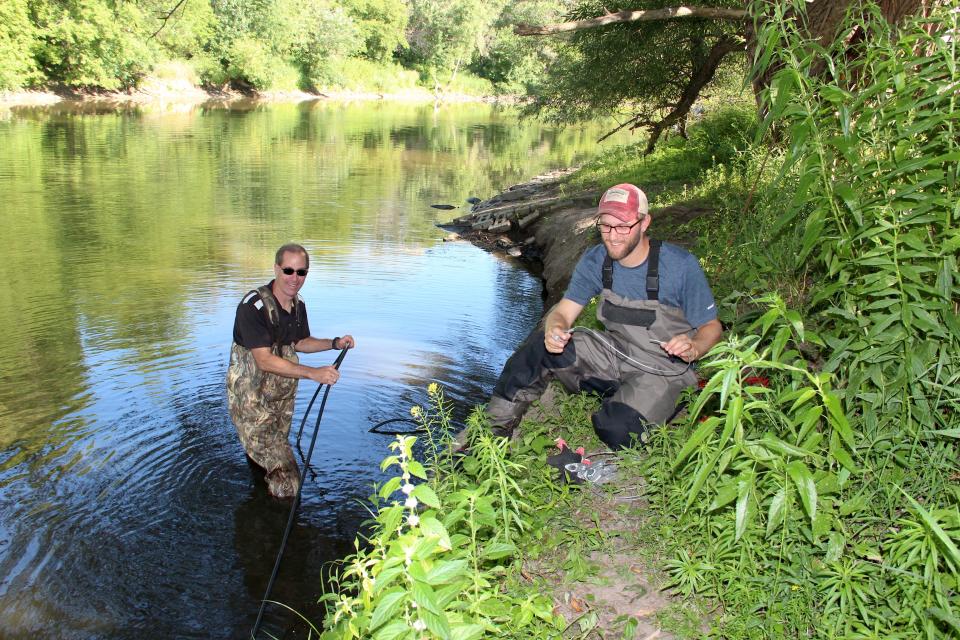More sturgeon have been detected migrating up the Milwaukee River, but spawning is likely years away

Eighteen lake sturgeon were detected migrating upstream this spring in the Milwaukee River, according to data from the Department of Natural Resources.
The number is a modern-era record and was cheered by sturgeon recovery advocates but comes with two caveats: It was the first year a high-tech sensor, installed in summer 2021, was in place to monitor the spring fish run; and the lack of sturgeon sightings farther upstream highlights the need for projects to improve fish passage in Estabrook and Kletzsch parks.
The sturgeon "hits" this spring came from a sensor array installed last year across the riverbed between North and Locust avenues.
The system detects and reads passive integrated transponder (PIT) tags implanted in fish.
Much like the chips in pet dogs and cats, the PIT tags carry unique identification numbers and allow fisheries staff to say with certainty where a fish was tagged, released and subsequently traveled when picked up by a detector.
Fishing in Wisconsin: Here's what you need to know about fishing in Wisconsin
Smith column: Fred Prehn's dishonorable actions will continue to drag down Natural Resources Board
The 2022 data show 16 sturgeon raised more than a decade ago at Riveredge Nature Center in Saukville and released in the Milwaukee harbor swam upstream this spring in the river.
Two other sturgeon were similarly detected that were raised and released in the Kewaunee River in Kewaunee.
Both release sites are part of a program to restore sturgeon populations where the fish were present historically but wiped out after large-scale settlement and development of the Great Lakes region resulted in dams that prohibited access to spawning areas as well as pollution and habitat destruction.
The Milwaukee River program, implemented by DNR staff and Mary Holleback, citizen science manager at Riveredge Nature Center, and a crew of volunteers, has been releasing sturgeon since 2006.
All of the 19,174 sturgeon raised at Riveredge and released in the Milwaukee have been implanted with PIT tags.
Until recently, a PIT-tagged fish had to be netted and checked with a handheld sensor to determine its origin. Now one need only swim over the array to get documented.

The new sensor has provided great news, Holleback said.
"We're overjoyed that some of the fish from 2008 to 2011 returned," Holleback said. "Up until this year we've pretty much been raising and releasing sturgeon based on faith that they would return someday. Now we have proof."
The Riveredge hatchery is active again this year and the sturgeon fingerlings are doing well, Holleback said. The program is on track to release about 1,000 sturgeon Sept. 25 at Sturgeon Fest, part of Harbor Fest in Milwaukee.
Since it takes sturgeon from 15 to 25 years to reach sexual maturity, the watch for spawning activity in the Milwaukee has ramped up in the last couple years.
However, no spawning behavior was observed. Sturgeon are conspicuous by massing and splashing in the shallows as they lay eggs and spread milt.
Since males mature earlier than females, it is assumed all the fish that came upriver this year were males, said Aaron Schiller, DNR fisheries biologist. The arrival of females is likely at least a few years away.
Schiller said the sturgeon exhibited a range of behaviors.
"Some of them went up above the sensor and stayed up," Schiller said. "Others dropped back down and then came back again. But we were detecting sturgeon in the river from mid-April through the end of May."
Data and observations from this spring's run has helped highlight challenges to restoring native fish migrations in the river.
Of 32 northern pike implanted with PIT tags earlier this year below the old North Avenue dam site, only one was detected less than a mile upstream at the sensor array. The river near North Avenue features a trough with current typically too strong in spring for northerns to swim through, according to DNR fisheries staff.
Fisheries experts have expressed concern, too, that at least some sturgeon aren't able to navigate through the flow.
And the river features drops or falls in Estabrook and Kletzsch parks that prohibit many other fish, including sturgeon, from passing upstream.
Schiller said about 2,000 cubic feet per second of flow is needed for fish to get over Estabrook falls and there was only one event of that magnitude this spring.
About twice as much is needed for fish to pass above Kletzsch falls, Schiller said, and there was no report of sturgeon this year above that part of the river.
Discussions and proposals for improving fish passage at Estabrook and Kletzsch, including fishways around the falls, have taken place for several years but no project has been implemented.
This year's northern pike data has also shed more light on the need to reconfigure the riverbed at the old North Avenue dam site.
Such work may be critical final planks to allow sturgeon access to adequate spawning habitat so they can reproduce naturally and build a self-sustaining, wild population in the river, the ultimate goal of the Milwaukee restoration program.
Our subscribers make this reporting possible. Please consider supporting local journalism by subscribing to the Journal Sentinel at jsonline.com/deal.
DOWNLOAD THE APP: Get the latest news, sports and more
This article originally appeared on Milwaukee Journal Sentinel: More sturgeon detected migrating up Milwaukee River: Wisconsin DNR

